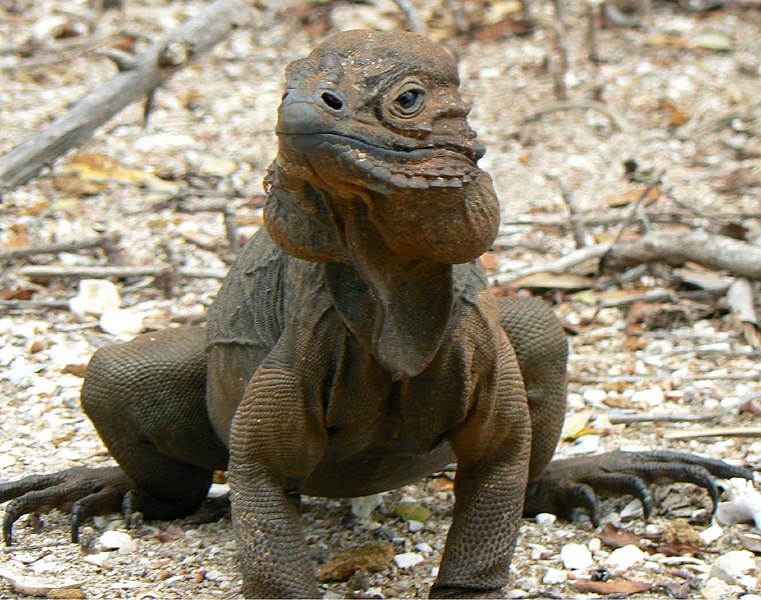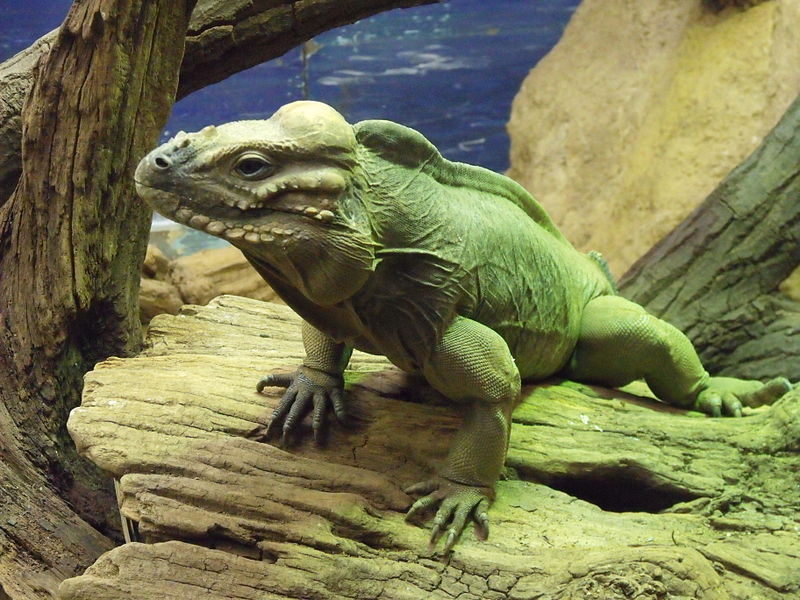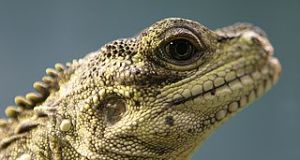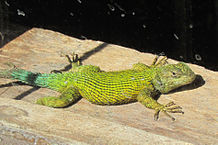 Rhinoceros Iguanas (Cyclura cornuta cornuta) rank among the most “personable” of the lizards I’ve worked with. However, due to their size, unique needs and powerful jaws (please see below), the decision to keep these magnificent animals must not be made lightly.
Rhinoceros Iguanas (Cyclura cornuta cornuta) rank among the most “personable” of the lizards I’ve worked with. However, due to their size, unique needs and powerful jaws (please see below), the decision to keep these magnificent animals must not be made lightly.
Description
The “bulldog-like” body is stoutly-built and colored uniform gray, brown, olive-brown or nearly-black. Rhinoceros Iguanas reach 4 feet in length, but appear larger due to their bulk.
The massive head of the male is topped by 3 horn-like tubercles and a thick adipose (fat) pad. The head and horns of females are smaller. Both sexes have large throat pouches and crests of pointed scales along the spine and tail.
Range
The Rhinoceros Iguana is limited to Hispaniola (Haiti and the Dominican Republic) and several small nearby islands. Navassa and Mona Islands are home to 2 additional subspecies, but the Navassa Island animal may be extinct.
The genus contains 7 other species. All are island endemics (Cuba, Jamaica, Caymans, Bahamas) and critically endangered.
Habitat
Dry, rocky cactus and thorn bush scrub forms the primary habitat. In earlier times, populations were concentrated along the coastline, but development has now pushed most into the island’s interior.
Rhinoceros Iguanas are diurnal and shelter in long, self-dug burrows.
Status and Conservation
Populations have plummeted due to development, logging, over-grazing, limestone mining and predation by introduced rats, cats, pigs, mongooses and dogs. Over half of their habitat in the Dominican Republic is gone, and the remainder is severely degraded; the situation appears far worse in Haiti.
The Dominican Republic has protected Rhinoceros Iguanas for over 20 years, but hunting for the table continues in Haiti. They are listed on CITES Appendix I and classified as “Vulnerable” by the IUCN.
A number of zoos and hobbyists are breeding this animal, and predator-removal and reintroduction programs are in place in the Dominican Republic.
C. cornuta stejnegeri, the subspecies on Mona Island, is protected under the US Endangered Species Act. A disease that causes blindness often affects the Mona Island’s iguanas; research is in progress.
Rhinoceros Iguanas in Captivity
Reproduction
Male Rhinoceros Iguanas fight for breeding opportunities. Mating occurs in May and June. In August, females excavate nesting burrows that may reach 5 or more feet in length. Their 5-30 eggs are deposited at the end of the burrow and are guarded for at least part of the 4-5 month incubation period. Sexual maturity is reached in 5-9 years.
Diet
Adults are largely herbivorous, consuming plants, berries, seeds and the pads, flowers and fruits of cacti. At certain times of the year, land crabs, snails and beetle grubs comprise much of the diet; dead birds and fish are also taken.
The young eat proportionately more animal prey than do adults. Rhinoceros Iguanas vigorously defend temporary food sources, such as fruiting trees.
Captives show evidence of well-developed learning abilities. One under my care for many years approached immediately at feeding time but learned that 2 people entering the exhibit, even if bearing food, meant trouble (i.e. restraint for medical treatment). If 2 people entered its exhibit, the lizard would immediately retreat.
Long term captives may become quite calm, but the danger from their immensely powerful jaws is ever-present. My thumb was severely injured by a “tame” specimen; it was only by chance that I escaped permanent nerve damage.
Further Reading
Breeding the Rhinoceros Iguana at the Australia Zoo.
Rhinoceros Iguana Conservation.
Video of wild Rhino Iguana.
Green Rhino Iguana image referenced from wikipedia and originally posted by Elliot Brown
 That Reptile Blog – Reptile, Amphibian and Exotic Pet Care and Information
That Reptile Blog – Reptile, Amphibian and Exotic Pet Care and Information




